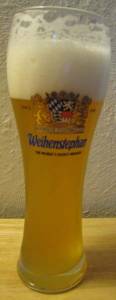Summer is upon us, and I am sad to say the kegerator is only functioning at 50% capacity – one tap. I was supposed to have the second tap full of a new batch of Engine 97, but disaster struck and I had to toss that batch. I was nervous when I brewed up my next batch, but my extra cleaning and sanitation efforts paid off and the summer wheat exceeded my expectations.
Summer Wheat
I love wheat beers, especially in the summer. Hefeweizens, witbiers, American wheats, it doesn’t matter…the more, the merrier. This year I’ve been trying to make an effort to brew some seasonal styles, and as the weather warmed up wheat beers jumped to the top of the list. A household favorite is Leinenkugle’s Sunset Wheat, and that was the benchmark I was shooting for. The recipe I used was pretty straightforward – 50% wheat malt, 50% 2-row pale malt, 1.0 oz of Cascade hops, and some coriander to spice it up. I added a touch of fruit flavoring at kegging – the recipe calls for blueberry, but I had some boysenberry around so I decided to use that. I’m not really sure what style this beer should be filed under, but since it has some fruit flavoring, let’s stick it in Fruit Beers (BJCP category 20, Fruit Beer).
The protein rest I used during the mash seems to have worked its magic – the beer pours with a nice head. It doesn’t stick around too long, but leaves some nice lacing on the glass as it recedes. The coriander gives a definite lemon flavor, which surprised me – I am fairly inexperienced with coriander, and I imagined it would give more of a peppery taste. Nope, it lends a citrus tang and a pithy bitterness (I have some grains of paradise I picked up which I think will get me closer to the pepper taste I was looking for…or, maybe I’ll try actual pepper…but that’s another spice for another brew).
The aroma is inviting, with nice citrus notes from the coriander and just a hint of the boysenberry flavor. More importantly, the beer tastes great! It was brewed with a very clean Kölsch yeast which lets the slightly creamy/slightly tart taste of the wheat really shine through. The coriander lends some lemon zest, and the boysenberry lurks in the background tying everything together with a faint sweetness. I don’t think you would be able to identify the boysenberry if you didn’t know it was in there – it’s a taste that leaves you smacking your lips wondering, “What is that?”
I have it carbonated fairly high, which gives it a nice crisp mouthfeel – this beer will not stick to your tongue. The body is perfect – just heavy enough to keep from being watery or thin, and just light enough to be a nice refreshing summer beer. I trust the protein rest helped out the body, but I will have to brew the recipe again without it to see to what extent that is true…
If I made one mistake on this brew, it was grinding the coriander too fine. I read that fine grinding would increase the coriander effect, and I wanted a strong coriander presence in the beer. However, I think the beer finishes a touch too pithy, just a little too bitter. However, others who have tried it don’t share that opinion, so that might just be me nitpicking. It definitely doesn’t take away from my enjoyment of a pint or two.
I think this has the makings of a new house brew, and I’m looking forward to using the same base recipe with different spices and flavorings during the summer. Wheat beers are pretty quick from grain to glass, which makes them perfect for experimentation.
Now – this beer doesn’t have a name, and I think you guys should help name it. Drop me a comment with your name recommendation and I’ll pick the one I like best and post the results. Who knows, the winner might even get a prize for their trouble!

